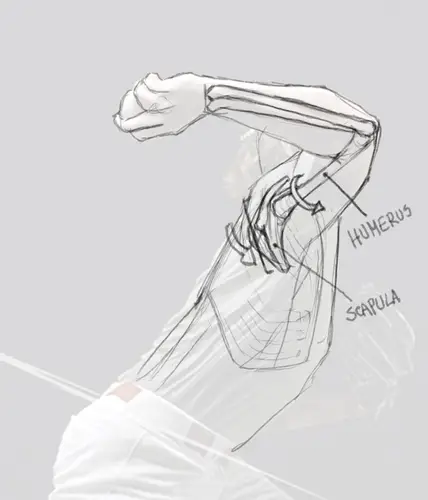<PART II: THE MUSCLES
THE AMAZING SHOULDER
PART III: IN SPORTS AND FITNESS
We use the shoulders for a great variety of activities. However, to illustrate how it operates, we will put a couple of sports and a classic exercise in the spotlight.

IN SPORTS
Sports bring a whole new dimension to the actions the shoulder can perform. We (all moving creatures) are designed to “work as a unit”; we don’t isolate muscles to perform any motion, and that doesn’t apply exclusively to sports but any quotidian task as well.
Even when we are analyzing a specific point in a typical motion of a baseball pitcher, the strength and flexibility of the shoulders play a pivotal role in virtually every sport.
BASEBALL PITCHING
In this artful video, professional baseball pitcher Drew Storen is meticulously analyzed in slow motion. The whole body works in a perfectly choreographic way to deliver at his level.
We will stop at the point of the maximum stretch of the shoulder, precisely at 47.21 seconds.

The most practical way to determine the muscles involved in any action is to observe the movement of the bones and what muscles should be recruited to accomplish that motion. Also, it’s essential to evaluate the force(s) against which those muscles are working (the resistance).
The scapula rotates on the sagittal plane to allow the humerus to rotate outwards. Thus, the humerus is adducted from the torso (frontal plane) over 90 degrees and impressively rotated backward (sagittal plane) over 150 degrees. Needless to say, this motion would hurt severely any average person without proper training, but can we still learn from it, analyzing the muscles stretching, contracting, or keeping the tension to accomplish such remarkable range.
CONTRACTING
Posterior Deltoid
Rhomboid minor
Serratus Anterior
Supraspinatus
Biceps Branchii
STRETCHING
Pectoralis Minor
Rhomboids Major
Teres Major
Infraspinatus
Subscapularis
Teres Minor
Latissimus Dorsi
Pectoralis Major
Anterior Deltoid
Triceps Branchii
ISOMETRICALLY
Trapezius
Clearly, a whole lot of motions are happening to place the arm in that position; but just at that exact point, all the muscles mentioned invert their role to move the arm forward in a very explosive way. The reason for such dramatic stretch is merely neurological. When muscles stretch, the spindles (stretch muscle-sensors) send an impulse to the spinal cord to activate more motor neurons at a spinal level that send an impulse back to the muscle. Inserting an analogy, muscles work somehow like a slingshot: the more it stretches, the more explosive force will generate.
It’s important to note that for our example, we are exclusively analyzing the motion of the shoulder, but Drew Storen is utilizing the whole body to throw the ball.
GYMNASTICS – MALTESE CROSS

Due to its extreme difficulty, the maltese cross isn’t something often seen in gymnastic competitions. The athlete must hold the pose for few seconds for the judges to validate it. Since it’s a static pose, all the muscles involved are working isometrically, fighting against gravity.
Although the bones are not moving, the high tension in the muscles involved prevents gravity from taking over and moving them.
As we stated with the previous example, we will analyze the shoulder muscles, but it’s evident that the whole body is involved in this pose.
Without the strength of those muscles, the humerus would rotate inwards and back in the sagittal plane, and the scapula would slide in the direction of the spine.
So now we need to point at the muscles that work precisely in the opposite direction:
Pectoralis Minor
Pectoralis Major
Anterior Deltoid
Infraspinatus
Subclavius
Teres Minor
Biceps Branchii
The tension of those muscles makes it possible for the athlete to hold the position while fighting against gravity.
IN FITNESS
There is almost an incalculable number of exercises that require the utilization of the shoulder. Often, they get tagged as great exercises for the chest, the back, or even the core, but without the shoulders, it wouldn’t be possible to execute them.
MUSCLES ACTIVELY INVOLVED
Pectoralis Minor
Serratus Anterior
Pectoralis Major
Anterior Deltoid
Subclavius
Triceps
CONCLUDING
The shoulder is simply beyond amazing, but its versatility brings along an intricated combination of muscles and bones working in perfect harmony to perform quotidian tasks. Although there are some cases in which it’s crucial to exercise muscles in an isolated way (mostly in physical therapy), it’s essential to keep in mind that the body is designed to work as a unit. Therefore, compound exercises are the most efficient way to achieve any fitness goal.
